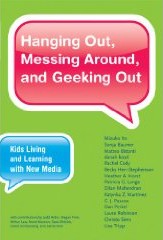This post was originally written for the DML Central Blog. If you’re interested in Digital Media and Learning, you definitely want to check this blog out.
 As adults, we take social skills for granted… until we encounter someone who lacks them. Helping children develop social skills is viewed as a reasonable educational endeavor in elementary school, but by high school, educators switch to more “serious” subjects. Yet, youth aren’t done learning about the social world. Conversely, they are more driven to understand people and sociality during their tween and teen years than as small children. Perhaps its precisely their passion for learning sociality that devalues this as learning in the eyes of adults. For, if youth LIKE the subject matter, it must not be educational. Unfortunately, I fear that we are doing a disservice to youth by not acknowledging the social learning that takes place during this period. Worse, what if our efforts to curtail social interactions out of a preference for “real” learning have professional costs?
As adults, we take social skills for granted… until we encounter someone who lacks them. Helping children develop social skills is viewed as a reasonable educational endeavor in elementary school, but by high school, educators switch to more “serious” subjects. Yet, youth aren’t done learning about the social world. Conversely, they are more driven to understand people and sociality during their tween and teen years than as small children. Perhaps its precisely their passion for learning sociality that devalues this as learning in the eyes of adults. For, if youth LIKE the subject matter, it must not be educational. Unfortunately, I fear that we are doing a disservice to youth by not acknowledging the social learning that takes place during this period. Worse, what if our efforts to curtail social interactions out of a preference for “real” learning have professional costs?
Very few of us work in professions where we are forced to focus on one anti-social task all day, every day. Even academics, a notoriously hermitic bunch, have to interact with students, fellow faculty members, and perhaps grant makers at some point. Most of us are constantly relying on and honing our social skills, developing new techniques to communicate our message, navigate office politics, manage someone’s expectations, and keep the peace. Those in service jobs face this in an acute way, having to manage irate customers and balance many people at once. Social skills are the bread and butter of professional life. So how do we learn them?
It’s easy to point to middle school as ground zero of youth drama. The rise of status hierarchies combined with budding sexuality throws all sorts of relationships upside down. Bullying, social categories, and popularity are all there. But the key to “surviving” middle school is learning how to navigate these muddy waters with an intact self-esteem. It’s not that jealousy and other social dramas disappear after middle school; it’s that they get much more nuanced as people’s skills improve. But for people to improve their skills, they must learn how to manage unpredictable and uncomfortable social situations. These aren’t skills learned in abstract; they’re learned through practice.
Over the last three decades, youth lives have gotten increasingly structured. Many youth spend little to no time in unstructured social settings, otherwise known as “hanging out.” The practice of hanging out is consistently demonized by educationally-minded folks as a waste of time. Yet, it is in that space where youth learn to navigate social situations, make sense of impression management, and develop the social skills necessary to be productive adults.
Social media has created an interesting rupture in the landscape. Youth turn to it to reclaim unstructured social encounters, to create a public space that allows them to simply hang out with their friends, peers, and cohort. The flirting, gossiping, and joking around that takes place is not proof that social media is useless, but proof that it’s extremely valuable. Without other spaces in which to gather, youth have developed their own. They want to be social, but we also need them to develop social skills. What’s fascinating is that they’re learning to do so in a mediated landscape, developing norms that will persist through adulthood. It’s not like all social encounters between adults are face-to-face; learning how to interpret a Facebook post is a great skill to have when entering an email-centric corporation.
Rather than demonizing social media or dismissing its educational value, I believe that we need to embrace the environments that youth are using to gather and help them learn to navigate the murky waters of sociality. We cannot “fix” their social worlds, but we can provide the scaffolding that they need to help learn to make sense of sticky social situations. We can serve as listeners, guides, and cheerleaders. We can be there when they’re trying to make a decision about a best way to handle a situation and play devil’s advocate when they need to work through complicated dynamics. But to be there for youth, we have to treat them with respect and value what they’re learning. We have to value the importance of learning about sociality. And we need to be able to listen as confidants, not judges.
We can continue to demonize social spaces, dismiss hanging out, and overly regulate our kids. But I believe this does them a disservice. Being a successful adult in society requires social skills. And we desperately need to give youth space to learn them. They’re committed to learning; why aren’t we supporting them in doing so?
Originally posted here.
—-
French translation by Marie Helene Visconti:
La socialité est un apprentissage:
En tant qu’ adultes, nous considérons les compétences sociales comme données… jusqu’à ce que nous rencontrions quelqu’un qui en manque. Aider les enfants à développer des compétences sociales est vu comme un projet éducatif raisonnable en élémentaire, mais dans le secondaire, les éducateurs passent à des sujets plus sérieux. Cependant, les jeunes n’ont pas fini d’apprendre sur le monde social. Inversement, ils sont plus amenés à comprendre les gens et la socialisation pendant la préadolescence et l’adolescence que lorsqu’ils étaient petits enfants. Peut-être est-ce leur passion à apprendre la socialisation qui dévalue ceci comme apprentissage dans le regard des adultes. Parce que si les jeunes aiment le sujet, il ne doit pas être éducatif. Malheureusement, je crains que nous ne rendions pas service aux jeunes en ne reconnaissant pas l’apprentissage social qui se produit durant cette période. Pire, et si nos efforts pour réduire les interactions sociales à cause d’une préférence pour le « vrai » savoir avaient un coût professionnel.
Bien peu d’entre nous travaillent dans des professions où nous sommes forcés de nous focaliser sur une tâche solitaire toute la journée, chaque jour. Même les universitaires, un groupe d’ermites notoires, doivent interagir avec les étudiants, leurs collègues et peut-être les donateurs à certains moments. La plupart d’entre nous nous appuyons constamment sur nos compétences sociales que nous aiguisons, développant de nouvelles techniques pour communiquer notre message, naviguer dans la politique d’entreprise, gérer les attentes de quelqu’un et maintenir la paix. Ceux qui sont dans le secteur des services sont confronté à celà de façon aigüe, ayant à gérer des consommateurs irrités et à s’occuper de plusieurs personnes en même temps. Les compétences sociales sont le pain et le beurre de notre vie professionnelle. Alors comment les apprenons nous ?
Il est facile de désigner le collège comme point de départ du drame de la jeunesse. La montée des hiérarchies de statuts combinée avec la sexualité bourgeonnante met sans dessus dessous toutes sortes de relations. Le harcèlement, les catégories sociales et la popularité sont pleinement là. Mais la clé pour « survivre » au collège est d’apprendre à naviguer dans ces eaux troubles en gardant l’estime de soi intacte. Ce n’est pas que la jalousie et les autres drames sociaux disparaissent après le collège ; c’est qu’ils deviennent plus nuancés à mesure que les gens amélioent leurs compétences. Mais pour que les gens améliorent leurs compétences, ils doivent apprendre à gérer les situations sociales imprévisibles et inconfortables. Ces compétences ne sont pas apprises en théorie ; elles sont apprises par la pratique.
Pendant les trois dernières décades, la vie des jeunes s’est structurée de façon croissante. Beaucoup de jeunes passent de peu à aucun temps dans des environnements non structurés socialement, autrement dit à « traîner ». La pratique de l’activité traîner est constamment diabolisée par les personnes à l’esprit éducatif en tant que perte de temps. Cependant, c’est dans cet espace que les jeunes apprennent à naviguer dans des situations sociales, à maîtriser la gestion de l’impression et à développer les capacités sociales nécessaires pour être des adultes protecteurs.
Les média sociaux ont créé une rupture intéressante dans ce paysage. Les jeunes se tournent vers eux pour retrouver des rencontres sociales non structurées, pour créer un espace public qui les autorisent à tout simplement traîner avec leurs amis, pairs et cohorte. Le flirt, les potins et les plaisanteries qui y prennent place ne sont pas la preuve que les médias sociaux sont inutiles, mais la preuve qu’ils ont une immense valeur. Sans d’autres espaces pour se rassembler, la jeunesse a développé les siens. Ils veulent être sociaux, mais nous avons aussi besoin qu’ils développent des capacités sociales. Ce qui est fascinant, c’est qu’ils sont en train d’apprendre à le faire dans un paysage médiatique, développant des normes qui persisteront à l’âge adulte. Ce n’est pas comme si toutes les rencontres sociales entre adultes se passaient en face à face ; apprendre à interpréter un post facebook est une compétence précieuse à posséder lorsqu’on entre dans une entrepise organisée autour du mail.
Plutôt que diaboliser les média sociaux ou nier leur valeur éducative, je crois que nous devons nous engager dans l’environnement que les jeunes utilisent pour se réunir et les aider à naviguer dans les eaux troubles de la sociabilité. Nous ne pouvons pas arranger leurs mondes sociaux, mais nous pouvons fournir les échafaudages dont ils ont besoin pour apprendre à se débrouiller des situations sociales délicates. Nous pouvons servir d’auditeurs, guides et cheerleaders. Nous pouvons être là quand ils sont en train d’essayer de décider de la meilleure façon de gérer une situation et jouer l’avocat du diable lorsqu’ils ont besoin d’évoluer à travers des dynamiques complexes. Mais pour être là pour les jeunes, nous devons les traiter avec respect et valoriser ce qu’ils sont en train d’apprendre. Nous devons reconnaître l’importance d’apprendre sur la sociabilité. Et nous devons être capables d’écouter en confidents, pas en juges.
Nous pouvons continuer à diaboliser les espaces sociaux, interdire l’activité « traîner » et excessivement réguler nos enfants. Mais je crois que nous leur rendons alors l’inverse d’un service. Etre un adulte qui réussit en société demande des compétences sociales. Et nous avons un besoin crucial de donner aux jeunes l’espace pour les apprendre. Ils sont motivés pour apprendre; pourquoi ne les soutenons nous pas?
 Last week, I gave a talk at Web2.0 Expo. From my perspective, I did a dreadful job at delivering my message. Yet, the context around my talk sparked a broad conversation about the implications of turning the backchannel into part of the frontchannel. In the last week, I’ve seen all sorts of blog posts and tweets and news articles about what went down. At this point, the sting has worn off and I feel that it would be responsible to offer my own perspective of what happened.
Last week, I gave a talk at Web2.0 Expo. From my perspective, I did a dreadful job at delivering my message. Yet, the context around my talk sparked a broad conversation about the implications of turning the backchannel into part of the frontchannel. In the last week, I’ve seen all sorts of blog posts and tweets and news articles about what went down. At this point, the sting has worn off and I feel that it would be responsible to offer my own perspective of what happened.